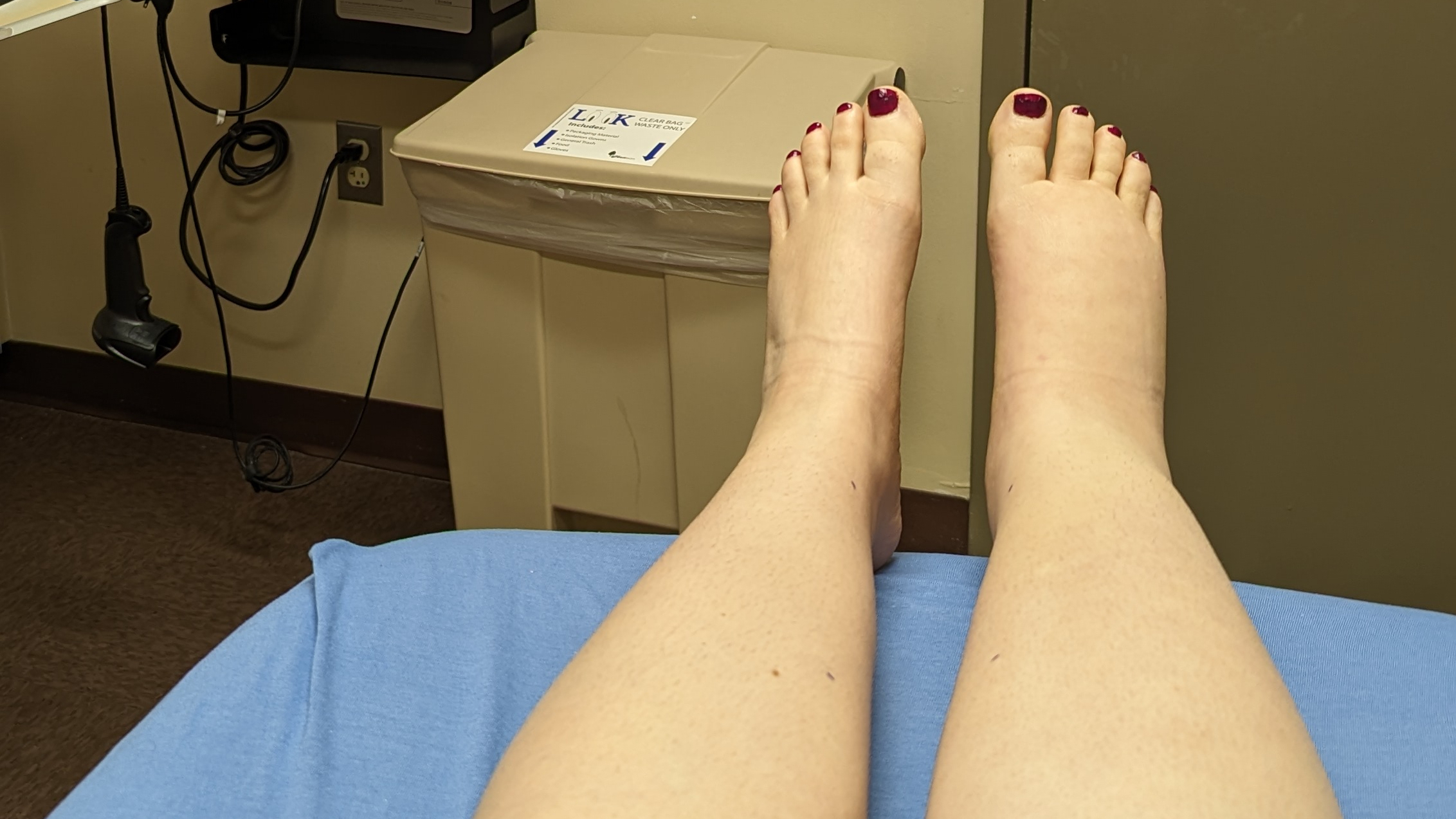Living with lymphedema can be a real pill — but what if it could be treated with one?
Recent studies indicate it’s possible, and may even be a reality sooner than we think thanks to clinical trials of a drug called ubenimex.
Last summer I wrote about the ubenimex trials, which at the time of writing had just kicked off by dosing their first patient. The news generated a huge response from the lymphedema community — one of hope, excitement, and lots of curiosity — so I’m back with an update!

I recently had the incredible opportunity to speak with Dr. Joanne Quan, Chief Medical Officer at Eiger BioPharmaceuticals, a biopharmaceutical company focused on the research, development, and commercialization of therapies for orphan diseases; they are also sponsoring the ubenimex clinical trial.
Dr. Quan and I talked about the ubenimex trial, the Stanford studies, and the important role patients play in the development of new therapies… this is a long post, lymphies, but you’re gonna want to read it all. So get comfy and #StayElevated — lots of exciting info ahead!
The Stanford Studies
Before getting into the details of the clinical trial, it’s important to know a little about the research behind it.
“There’s been some really great research that’s been done at Stanford University by Dr. Stanley Rockson and Dr. Mark Nicolls, who have collaborated on this,” Dr. Quan said.
The research from Stanford University School of Medicine is really great: it not only reveals the molecular mechanism responsible for triggering lymphedema, but also presents a drug with the potential for inhibiting that process altogether.
Traditionally, lymphedema is regarded as a “plumbing problem,” where the buildup of lymph fluid is caused by a clog somewhere in the “pipes” of the lymphatic system. Although this is definitely part of it, the researchers at Stanford have discovered that the accumulation of lymph may actually be caused by inflammatory responses within the tissue of the skin.
Studying both animal models of lymphedema and humans with the disease, the researchers found a naturally occurring inflammatory substance called leukotriene B4 (LTB4) present in elevated amounts, and determined that these high levels were causing tissue inflammation and impaired lymphatic function.
Using mice that were given lymphedema, the researchers focused on finding a therapy that would directly address this biological process on a molecular level through pharmacological agents that would specifically target LTB4 production.
“What ubenimex does is decrease the levels of LTB4,” explained Dr. Quan. “And what they did was use this particular compound in the mice who were given lymphedema. They found that mice who got treated with the ubenimex actually had much improved lymphedema.”

The study’s findings, which were recently published in Science Translational Medicine, indicate that researchers were able to induce lymphatic repair and reverse symptoms of the disease in mouse models of lymphedema by using ubenimex, which blocks the enzyme that generates LTB4.
“What we’re doing in the clinical study is to take the drug and see if it works in people,” Dr. Quan said. “As you can imagine, people are a bit different than mice, but I think we actually have some really good experimental evidence that suggests that this may work in people, and that’s why we’re doing this particular study.”
ULTRA Study

Ubenimex (also known as bestatin) has been used for decades in Japan to treat cancer with little to no side effects, and has been found to work well as an LTB4 inhibitor. It’s not approved for use in the United States, although it’s currently being tested as a treatment for secondary lymphedema in a clinical trial sponsored by Eiger BioPharmaceuticals known as ULTRA.
ULTRA stands for “Ubenimex in Adult Patients With Secondary Lymphedema of The Lower Limb: a Phase 2, RAndomized, Double-blind, Placebo-controlled Study of Efficacy, Safety, and Pharmacokinetics” and is exactly what its name says. (Although I see why they chose the acronym — much easier to remember!)
In the study, participants take their dose in capsule-form three times a day for 24 weeks. Then, around a month after the drug is stopped, there’s a safety follow-up. All-in-all, the total participation time is about an eight-and-a-half to nine month commitment.
The study is randomized and double-blind, meaning the patients are randomly assigned to receive either the active drug ubenimex or a placebo, and neither the patients nor the researchers know who’s taking what.
“We designed this particular study to give a really unbiased view of how the drug might be doing, and part of that is doing it blinded,” Dr. Quan said. “In the end, when all the patients are recruited and all complete the treatments — then we do what we call ‘unblind,’ and we essentially open the envelope and see who was on what.”
As a result of it being a blind study, the researchers won’t know if ubenimex works or not until after the study is completed and they review the data.
But what about primary?
Upon hearing about the study, many primary lymphedema patients — myself included — wondered if this would work for us, too, despite the trial focusing on patients with secondary.
“We chose to study secondary lymphedema of the lower legs really as an initial disease entity to study,” said Dr. Quan. “Obviously, if this works, then we have a lot of thoughts and plans to move forward into primary lymphedema, and also looking at lymphedema of the arm and other body parts, essentially.”
“The mechanism that this drug has is really fairly broad,” Dr. Quan reassured. “And so, potentially, it could work for lymphedema of many types.”
What this means for patients
“Ubenimex is in a capsule, so this would be different than any of the other therapies that are available for lymphedema,” Dr. Quan said. “I think that part’s potentially pretty attractive for lots of people who are already spending a fair amount of time and energy managing the other aspects of their lymphedema.”
The drug wouldn’t replace the need for regular lymphedema treatment, however, and the study is not claiming to be a standalone treatment.
“It’s still the early days,” Dr. Quan cautioned. “So we don’t know whether this works, and we don’t know whether this may work in people who aren’t using compression. Ideally, everyone should be doing manual lymphatic drainage, compression, you know — all those other things. And we want to see if this works on top of that.”
“Now, at some point it may make sense to see if we can replace some of those,” Dr. Quan continued. “But I think that’s a different type of study right now.”
Get involved!
Studies like these are a collaborative effort from both the professional side and the patient side, too. There’s not been a whole lot in the way of pharmaceutical interventions for lymphedema, so a study like this could really pave the way for other companies and treatments to follow.
“We’re sort of taking a bit of a leap entering into this space, but it’s best if we can do it as a collaborative effort with other members of the community,” Dr. Quan said. “I think, sometimes, people are a bit afraid of things that haven’t been done before. But I think here’s an opportunity for folks who see that there’s a need for something better to get involved.”
ULTRA is currently enrolling participants at four study sites: Stanford University in Stanford, California; The Ohio State University Wexner Medical Center James Cancer Hospital in Columbus, Ohio; Orlando Health, Inc., in Orlando, Florida; and Macquarie University Hospital in New South Wales, Australia.
If you’re interested in participating in the study, click here to visit the study’s website. There, you can learn more about ULTRA and take a study screener to see if you’re eligible to participate.
Pending the results of the current ULTRA study, Eiger is planning additional studies of ubenimex for lymphedema — so even if you aren’t eligible for the current study, you may be in the future!
Before you make the decision to participate in any clinical trial, though, it’s important to educate yourself first on what it means to participate so that you can make an informed decision — the NIH is a wonderful resource for this.
“I encourage people to think about it. Ask their doctors, talk to them, research about clinical trials and what it means to participate in one,” Dr. Quan said. “There are a lot of different things that folks who have lymphedema can do that may help develop other therapies as well.”
Final thoughts
“As a small company, Eiger has come to understand the unmet need here, and what a challenge it is for you and for other folks like you,” Dr. Quan said. “And so we’re stepping forward to say, ‘Hey, let’s just try to do something.’”
“There’s a number of steps and kind of a road ahead,” Dr. Quan said as we began wrapping up our call. “But we’re committed to taking that first step, and this is a collaborative effort with everyone within the lymphedema community.”
What do you think about a drug treatment for lymphedema? Would you take the pill? Let me know in the comments below!

I want to give a huge thank-you to Dr. Quan for taking the time to speak with me, as well as clinical program manager Erica McCluskey and senior director of clinical operations Tristen Moors at Eiger!
*Edited 05/16/2017 @ 9:15 AM to include study site locations.




Leave a Reply to Alena FordCancel reply